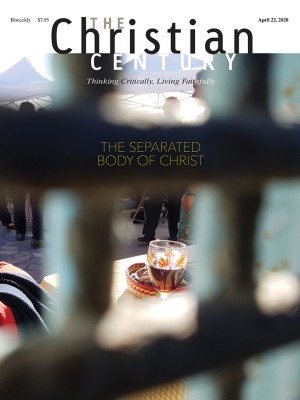How I learned to love worshiping via video call
I'm immunocompromised. My ability to attend worship has long been determined by the CDC.

On a Sunday morning last December, the FaceTime notification sound chirped on my phone at 9:30 a.m. When I tapped the glass, there was a live view of my church’s sanctuary, beautifully decorated for Advent—but sideways, with the stained-glass windows seemingly on the floor. This sideways view of the sanctuary was alternating with a way-too-close-up view of my pastor’s nasal passages (some things cannot be unseen!) followed by her labored breathing and finally by, “I’m trying to set up my tripod to FaceTime you into worship!”
“The church is upside down and sidewise,” I helpfully volunteered.
“I know!” she shot back, frustrated and already late for the adult forum between worship services.
I’m a chronically ill person. I’ve had almost ten years of chemotherapy, and I have a truly broken, fractious immune system. I’m one of the many people who could die from a simple virus. You know the list: “Infants and children, the elderly, and those with suppressed immune systems.” My ability to be physically among the body of Christ in worship has long been determined by the daily statistics from the Centers for Disease Control and Prevention.
Read our latest issue or browse back issues.
Back in October, months before the word coronavirus was on most people’s radar, as soon as the flu map showed “sporadic” influenza in New Mexico,
I began wearing my R95 respirator mask to church as my doctor ordered. Each Sunday I slipped quickly through the narthex into the nursing room where—because we have no babies currently—there was a safety wall of glass between me and every other member of the congregation.
I was struck during that first Sunday of isolation room worship by how far away everyone seemed, and by how sad I was to be alone at the edge of my congregation. I felt like Moses as he glimpsed the promised land that he couldn’t enter.
Worship is not a spectator sport. It’s not about observation but participation. It’s about meeting one another’s eyes, walking together toward the body of Christ, bowing together, communing together, singing together, being together. I wondered: Should I just stay home and be done with it until the CDC says the danger is over?
Then Pastor Joene came for a home visit and asked, “How about we FaceTime you into worship this week?”
After our awkward initial exchange that Sunday morning, I watched as she righted the tripod and attached her iPhone to it. My heart soared as I saw the blue Advent banners. I hadn’t seen them in years, since flu season always stretches through Advent.
I stopped banner gazing when I realized my pastor had not placed her phone in my usual pew, where I’d see the back of other worshipers’ heads. Instead, she’d set the tripod up immediately in front of the pulpit. I was eyeball-to-eyeball with the congregation.
We ended our clumsy set-up-the-camera call, with Pastor Joene letting me know she’d call me back for the organ prelude in about half an hour. I rinsed my breakfast dishes, brushed my teeth, and got dressed for worship—as if I were really going to be there. I poured myself a cup of hot tea and then put it down again. (How distracting would that be for the congregation—watching me sip tea via FaceTime during the liturgy?) I felt dubious about the entire experiment.
Back before my immune system broke, I was a professor of worship. My students and I had countless heated (and sometimes reasonable) discussions over the right use of technology in worship. Based on those conversations, I formed a rubric for incorporating technology into worship. It was pretty basic, as St. Benedict himself would have advised:
- If you use technology, it must fit seamlessly into the liturgy rather than causing a hiccup or bump.
- If you use technology, it must be with a particular goal in mind (e.g., this specific visual presentation is likely to speak directly to the soul of a millennial or Gen Yer with whom we wish to practice hospitality during worship).
- If you use technology, it must be flawless: no start-overs, no long pauses waiting for software to reboot, no images on the screen lagging awkwardly behind (or mismatching the moment) in the liturgy.
- If you use technology in your sanctuary, you need a tech-savvy team and a sanctuary that’s suitable for screen use (which likely means a sanctuary that’s not flooded with skylights and windows).
- If your church is in dire straits financially, a huge investment in technology is probably not the best stewardship of limited funds (although a better sound system is almost always a good thing).
My students used daily worship in our seminary chapel as a lab to experiment with technology. When it was done well—and for the right reasons—it was utterly incontestable that our worship was enriched. My students used some stunning visual resources that achieved what words alone could not, and the worshiping community was wonderfully responsive.
As I sat down to wait for my pastor’s second call that Sunday, I quickly reviewed my own technology rules. In hindsight, I realize that worrying about the right use of technology in worship—rather than as worship—was a prepandemic luxury. But at the time, I was nervous. I wondered how FaceTiming into worship could possibly feel any better than watching it from behind the nursing room glass.
I remembered an experience from my childhood. When I was six years old, I was ill for several weeks with the measles. In an effort to cheer me, my Aunt Shirley brought all four of my cousins from Stillwater, Oklahoma, to see me. They waved at me through the heavy glass patio doors. They were standing outside, bundled in coats, mittens, and scarves, while I was on the inside—sick and alone—in the living room. I wept for sadness at my isolation, at not being able to be with them. They felt so tantalizingly close and so dishearteningly unattainable. Sitting there waiting for my phone to chirp again, I remembered that sadness.
Then a miracle happened. Pastor Joene called, I touched the screen, and the prelude began soaring through my home. The beloved faces of the members of my congregation filled my screen. My heart lifted as if heaven itself had been trespassed. As our pastor began the confession, my brothers and sisters and I turned toward her and made the sign of the cross. The processional hymn began, and I was swept up into the mystery of worship. I stood in the sunroom of my home, my hymnal opened to the correct page, my cat staring wide-eyed with alarm as I sang out with abandon and joy. My fortunes had been restored and my time of exile ended.
Not everyone at the church was happy about my face staring at them on the iPhone screen throughout worship that morning. The professor in me knew that would be one response even before the negative reviews trickled in. Still, how marvelous it was to see their faces! How sweet it was to have a regular chat with my coffee hour buddies, who came to the screen after the postlude, waving and laughing. It was the shared life that I’d so deeply ached for in the isolation of my home.
A churchwide conversation followed (involving email, phone, texting, and even Instagram) about just where to put me in worship. One popular suggestion was on the organ console.
In the meantime, I was certain of one thing. The glass that once separated me from my cousins and decades later isolated me from the healthy worshipers at my church is the same sort of glass that could now—at a fingertip’s touch—conduct the gathered body of Christ directly into my home. It creates a breathlessly thin place where the distance between heaven and earth is, for a brief moment, suspended.
And now in this thin place, I am unexpectedly in the thick of community in a new way. Our communal vulnerability to COVID-19 means that we’re all now worshiping through glass.
Even before the New Mexico governor ordered that all public worship be suspended, our little church decided that worshiping in person was too dangerous. Instead of streaming worship, our liturgy team opted to use Zoom—“so we can see one another’s faces,” they said. I can’t help but wonder if this choice was influenced by my FaceTiming into worship over the past several months.
There were some hiccups. The first Sunday we used Zoom, one beloved matriarch couldn’t work out how to find the mute icon on her computer screen. Her small dog yapped throughout most of Pastor Joene’s homily. It’s a learning curve—for all of us. But we’re learning together.
A version of this article appears in the print edition under the title “Through a glass safely.”





